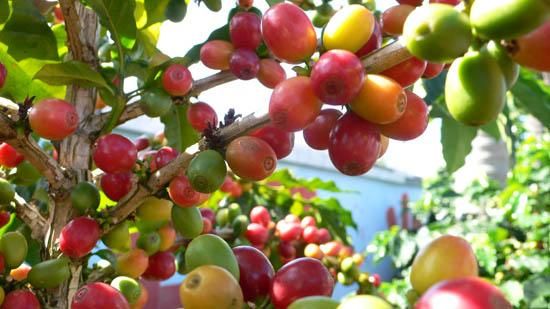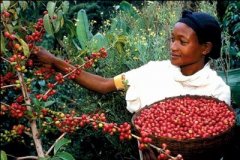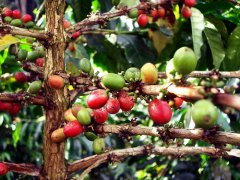Coffee producing areas in Latin America introduce what kind of coffee to drink, American-style coffee beans.
Fine coffee is fresh coffee. Whether it's food or drink, the fresher the better, and so is specialty coffee. Coffee beans should be kept fresh before making fine coffee, including the preservation of roasted beans, and the coffee beans should be ground before making, which is also to retain its most original and best flavor. The hand-brewed coffee making method is such a way to make fine coffee, and it is also one of the coffee making methods that can best retain the original flavor of coffee. Fine coffee is good coffee and harmless to health. Unlike coffee made with inferior coffee beans, fine coffee uses high-quality coffee beans. Freshly made coffee is harmless to health and beneficial to the body and mind when consumed in moderation.
Latin America (Latin America)
In 1721, French naval officer Gabriel Mathieu de Clieu took the first coffee sapling from Africa to Martinique in Latin America. All this is the origin of coffee cultivation in Latin America. Because France was under Bourbon rule, Arabica coffee grown in Latin America took on another name that is still famous in the coffee industry today, Bourbon. Bourbon is now an important branch of Arabica coffee. The overall flavor of Latin American coffee is known for its balance, and all the flavors in coffee can be found in Latin American coffee. The widespread use of wet processing of green beans is also one of the characteristics of Latin American coffee, and the good processing process also makes its beans more uniform in size and less defective than African coffee.

Peru aroma 3 points brightness 4.5 points mellow 3 points flavor 4 points aftertaste 4 points
Roast level: Full city/Espresso/Dark Medium and deep roast are best for Peruvian coffee beans, too light to show flavor and sweetness.
Peruvian coffee was not common in the world before, and it was generally considered that its processing process was sloppy, so it was not evaluated well, which was the result of being monopolized by the state before. In fact, Peru's coffee growing conditions are excellent, and many of them are organically grown, so the quality of coffee beans has always been quite good. Peruvian coffee is famous for its production in Chanchamayo, while Notre and Cuzco are also occasionally excellent. Good Peruvian coffee beans have good texture, acidity and complexity, combining the brightness of Central American coffee with the body of South American coffee.
Mexico aroma 3 points brightness 4 points mellow 3 points flavor 4 points aftertaste 4 points
Roasting level: Full cityfull city, Roast to two explosions from the beginning of the pot, whether mixed with the formula to make Espresso or brewed items, Mexican coffee beans can be said to be unique flavor.
Mexican coffee is produced from Cotepe and Veracruz in the north to Pulmas in the central Oaxaca region to Chiapas in the southernmost region, and the flavors vary from region to region. Although Mexico has many producing areas, because the quality stability is not high, it has to try many ways to pick high quality coffee. Basically, the coffee standards in Oaxaca and Chiapas are relatively neat. Chiapas is adjacent to the Huehuetenango region of Guatemala, so its flavor is similar. Mexico is also a major producer of certified organic coffee. Generally speaking, Mexican coffee flavor is lighter, but mild and delicate, and the aroma is good, so it is worth a try.
Colombia aroma 3.5 points brightness 4.5 points mellow 3.5 points flavor 4.5 points aftertaste 4.5 points
Roast: Medial/City/Full city/Espresso/Dark/French Colombia beans are among the few roasted beans that range from light to dark, from light to clean to dark sweet
Colombia beans will have different styles.
Colombia, once the second-largest coffee producer after Brazil but now third, overtaken by Vietnam, is the world's largest supplier of washed beans. Colombia has become synonymous with good coffee after years of image building. Although the flavor is balanced, the texture is thick, the acidity is bright, and the aroma is OK, but on closer inspection, most of the Colombia beans are mediocre and have little personality. When choosing Colombia beans, you can't just look at the grade mark, but pay attention to the production area, because Colombia is currently graded according to the size of beans, so the Supremo or Excelso on the coffee bag refers to the size of beans rather than the quality, but the size of beans actually has no inevitable relationship with the flavor of the entrance, but the altitude of the origin and the taste are closely related, so this grading system is often criticized by people. In fact, most of them,
South American countries have moved to elevation grading, but only Colombia maintains the traditional grading system, and many Colombia coffee-makers have recognized this and begun to demand a change in the grading system. Colombia's famous large producing areas include Medellin, Armenia and Manizales, so MAM is sometimes seen on the bag containing coffee, which means that the coffee beans may come from any of these three producing areas. Almost all of Colombia's finest coffee beans are grown on traditional small farms, which grow old coffee trees of the Typica species. The trees are good and the harvesting and handling procedures are careful, so the quality is extremely high, but the relative yield is also low.
Costa Rica aroma 3.5 points brightness 4.5 points mellow 3 points flavor 4.5 points aftertaste 4.5 points
Roasting level: Light/Medial/City If you want to show Costa Rica's perfect balance of flavor, you must not roast deeply. It is recommended that the City level can be used. Even the first explosion can be finished. At this time, the aroma and flavor will be combined. Close to the second explosion is the deepest limit of roasting. Do not enter the second explosion and waste good coffee beans.
Costa Rican coffee is praised by many gourmets as "complete coffee" because it is very balanced overall, the flavor is very clean and compact, the delicate acidity with green apple fragrance (sometimes citrus or plum fruit), the body is compact and not thin, after drinking the sweet taste of coffee will stay in the throat for a long time, so some people describe it as tasting "with perfect balance"! The best Costa Rican coffees have chocolate on the aftertaste. Costa Rica has a total of 130,000 large and small coffee plantations, the most famous of which are Tarrzu, near the Pacific coast in the south, and Sanshui River, north of the capital San Jose. Tres Rios, these areas are high altitude, good soil, so planting density is the most dense, coffee quality is quite stable, and the most famous of these many coffee farms is located in Tarasu, with a reputation of "tasting like a bell"(La Minita) Manor, La Minita Manor coffee is so excellent because of the cultivation of coffee trees to coffee beans are extremely careful and strict, in fact, the manor produces a lot of coffee beans a year, but qualified to hang La Minita name to sell the number is very small, the rest can only be screened to Tarasu coffee beans sold. Because Tarasu is too famous, the reputation of other producing areas is less known to the world, such as the Boers volcanic area and the Sanshui River producing area. The three volcanoes even produce excellent coffee in the northern Atlantic Ocean, such as Orosi. Another problem with strong brands is that many coffees that are clearly not Tarasu are mixed up with Tarasu photos, so trying them yourself is the only way not to be fooled.
Guatemala aroma 3.5 points brightness 4.5 points mellow 3.5 points flavor 4.5 points aftertaste 4.5 points
Suitable for roasting degree: Light/Medial/City light roasting, city degree can best show the characteristics of Guatemala coffee, too deep will reduce the fruit fragrance, if you like smoky flavor, you can roast close to two explosions, but still do not enter the principle of two explosions.
Important Notice :
前街咖啡 FrontStreet Coffee has moved to new addredd:
FrontStreet Coffee Address: 315,Donghua East Road,GuangZhou
Tel:020 38364473
- Prev

Ethiopia, the birthplace of African Africa coffee, is suitable for light roasted coffee beans.
Boutique coffee is fresh coffee. Whether it's food or drink, of course, the fresh the better, and so is boutique coffee. High-quality coffee should keep the coffee beans fresh before making, including the preservation of baked beans, and grind the coffee beans into powder before making, which is also to retain its original and best flavor. And the way of making hand-made coffee is such a way to make high-quality coffee.
- Next

Asian (ASIA) coffee beans, fine coffee, mellow coffee, smoking and coffee.
Boutique coffee is fresh coffee. Whether it's food or drink, of course, the fresh the better, and so is boutique coffee. High-quality coffee should keep the coffee beans fresh before making, including the preservation of baked beans, and grind the coffee beans into powder before making, which is also to retain its original and best flavor. And the way of making hand-made coffee is such a way to make high-quality coffee.
Related
- Does Rose Summer choose Blue, Green or Red? Detailed explanation of Rose Summer Coffee plots and Classification in Panamanian Jade Manor
- What is the difference between the origin, producing area, processing plant, cooperative and manor of coffee beans?
- How fine does the espresso powder fit? how to grind the espresso?
- Sca coffee roasting degree color card coffee roasting degree 8 roasting color values what do you mean?
- The practice of lattes: how to make lattes at home
- Introduction to Indonesian Fine Coffee beans-- Java Coffee producing area of Indonesian Arabica Coffee
- How much will the flavor of light and medium roasted rose summer be expressed? What baking level is rose summer suitable for?
- Introduction to the characteristics of washing, sun-drying or wet-planing coffee commonly used in Mantenin, Indonesia
- Price characteristics of Arabica Coffee Bean Starbucks introduction to Manning Coffee Bean Taste producing area Variety Manor
- What is the authentic Yega flavor? What are the flavor characteristics of the really excellent Yejasuffi coffee beans?

